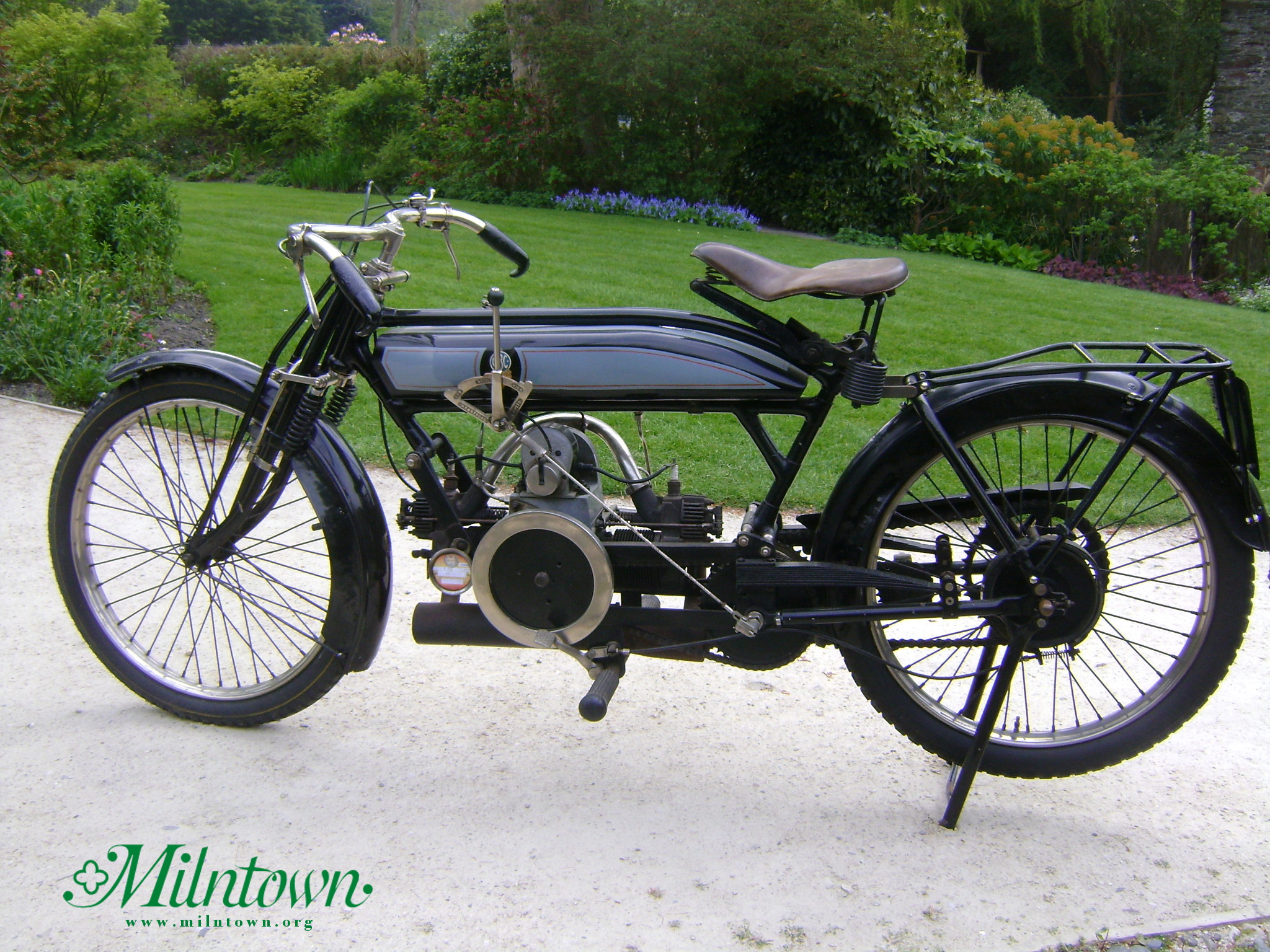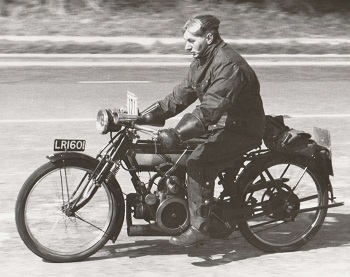The ABC 500cc motorcycle in the Milntown Trust Collection
One way or another, every member of this website must have heard about Bob Thomas. He appears in some pictures in the Gallery and used to own one of the largest collections of ABC vehicles (from bikes to cars, including a Skootamota and several engines) but more importantly, he used to own one of the oldest ABC 500cc motorcycles we know of.
He might not be with us anymore but his collection lives on and is still visible in Milntown on the Isle of Man.
In recent days some of the Milntown Trust volunteers registered on abcroadmotors.co.uk and shared some great pictures of their vehicles as well as a 1924 catalogue of spare parts for the ABC cars.
In among the many emails which were exchanged, there was a discussion about the date of production of their veteran 500cc motorcycle.
From previous discussions with several well-known site members, it was clear that the engine number of this veteran bike must be dated to 1914 and that would make it one of the first ABC motorcycles ever made for the public.
To my surprise however, the Milntown volunteers one day sent me an email with the picture of a note written by Bob Thomas himself providing some details as to why this could be a 1913 ABC prototype.
The note reports Bob’s memories of conversations which took place after the Second World War and clarify how the bike moved on through the years.
Some points might now be viewed as slightly inaccurate but, considering that information available at the time was limited and people tends to get confused or make assumptions, it might still be possible to read past some of those inconsistencies.
After 100+ years it might not be feasible to tell for sure if the 500cc bike is really a prototype or not but the note itself makes for interesting reading:
1913 A.B.C. MN8714 Originally LR1601.
This is a very interesting machine, not only is it the oldest ABC known to survive, it is the hand—built prototype for the 1914 model, and also it is thouht to have been the personal machine of the designer, Granville Bradshaw, but sadly this can not be proven. Certainly when I rebuilt it back in 1947, I took it over to show it to R. E. (Bob) Dicker at Addlestone (Near Brooklands) who we knew to have worked for ABC before 1914, when their works was at Brooklands Race Track. As soon as he saw it, he said, in his actual words,
"Christ almighty, where the hell did you dig that up. I MADE that!”
He then proceeded to point out bits that he had personally made from scratch, which included the starting arrangement. Now Bob Dicker was an interesting man. Not only was he a regular competitotr at Brooklands, holding several Records om Zenith machines etc, but after the war, in 1919, then working for Vickers, he was the mechanic sent over to Vewfoundland to assemble the Vickers Vimi airplane in which messrs Alcock & Brown made the first ever non-stop trans Atlantic flight.

Painting of Vickers Vimy over Brooklands by aviation artist Roy Anthony Knockolds (1911-1979)
Specially commissioned by Sir Clive Edwards and Bob Thomas in 1974.
The machine itself is interesting, as it is based around one of ABC's 500cc stationary engines which had been made for some years for generators and pump units and suchlike one of which in 1912 held a Brooklands record at 80.4 mph in a single geared ABC bike, ridden by Jack Emerson. These engines, unusual for that time were what is known as "square" that is, they have a bore and stroke equal, at 68mm. They also have steel cylinders, very light, and exhaust over inlet valve arrangement, that is, side inlet and overhead wxhaust valves, which is the reverse of the normal at that time, but gave better heat distribution. For it's day, it was very high revving, and very light. Here it is coupled to an Armstrong three speed hub gear, which would normally be fitted into the rear wheel like a bicycle gear, but in this case it is used as a countershaft gearbox. The frame has what is now called swinging arm rear suspension, and these arms pivot about the axle of the gear box, giving constant chain centres. The action is controlled by leaf springs, as can be seer;) and the mudguard support—cum carrier is arranged to keep the whole assembly laterally rigid. The front end has normal Druid type forks with coil springs. It handles surprisingly well, and is quite quick, it used to top 70mph, and could cruise at 60 in the days of less traffic -
I have personally held it at60 for some twelve miles between Bedford an Luton.
Nowadays of course brakes are the problem, bicycle front and contracting band rear. Of course when these vehicles were made, one practically never used, or indeed needed, brakes. No traffic, and gravel surfaced roads, brake hard and you dissapear through the hedge! .
In 1949-50s I used to ride it from London to Nottingham and Scarborough at weekends for rallies etc, and 100-120 mpg was not unusual.
I got it in 1946 from the man who bought it second hand in 1916, one R.C.(Dick)Meeson, who used it with a sidecar, the chassis of which he made himself, of flat spring steel, which, he claimed was copied by the Rudge cocern in the 1920s. He used to drive it regularly from London to North Wales.
He claimed he had covered 70,000 mile without a breakdown. When he stopped using it, 'in 1926, he took the engine out and used it to drive a generator to light his bungalow, which it did until 1943, by when it was rather worn out, but he kept it all. I was very lucky, as when I was told about it at a Vintage committee meeting, another friend, beside me, said I know where there is a brand new engine for that.. so the same evening I got a worn out bike and a new engine! , so I was able to reconstruct it to it’s present condition.
It has completed many Brighton Runs, always successfully
David Hales has been able to add more insights to the note above, clarifying some of the mistakes and also adding a wealth of information about those early days of motorcycle development at ABC:
I met Bob Dicker back in 1968 and visited him on a number of occasions. Because of his associations with the Alcock & Brown flight he was frequently called upon to write forewords to books on the subject, or with Brooklands racing, but like a lot of people who worked somewhere 50 or so years previously, the facts sometimes get a bit muddled!
The 500cc motorcycle engine was not based on any auxiliary engine; quite the reverse, the motorcycle unit was adapted for auxiliary work at a later date.
Bailey’s ABC-engined Douglas took records in December 1913 and probably caused Bradshaw to think about producing a complete motorcycle for the ABC company, and hence Emerson’s record machine appearing at Brooklands in January 1914. The reports are not entirely clear as to whether the frame was built at the factory, or by some other concern like Zenith who were just down the road in Weybridge, but whatever the truth, it did lead to the company making their own frames by March 1914 when the prototype production machine was shown to the press. This was said to be the ‘TT’ model with overhead valves, whereas the normal production model would be the ‘Touring’ model with exhaust over inlet valves. They had front forks with vertical leaf springs. There was then a booklet produced by the company dated June 1914, giving the names and addresses of shareholders of the new company - ABC Road Motors 1914 Ltd.(see below). Copies of the minutes of this company are also at Brooklands.
From these, the first meeting took place on 3rd June 1914, at which it was stated that 100 frames were being built at the works, the first dozen being ready for engines which were being made by the Commercial & Marine Co.(Hanwell), at the time they would be delivered (due 24th June 1914).
The second meeting on 10th June said that the first standard pattern machine had now been finished. Also noted was the first private order, plus 25 for New South Wales, 8 for New Zealand (in lieu of one from an earlier order), and 2 for Natal (in lieu of 1).
The third meeting was on 24th June, where it was noted that apart from Emerson competing on the ’TT’ machine, Lt. T C M Bellairs had won a competition in St Andrews (Scotland). From my own research, I have him noted as having a machine registered TS 1036 registered on 20th March 1914 in Dundee. Did he obtain the prototype that appeared in the press that month? There might be a photo in the scrapbooks now at Brooklands. Also at that meeting mention was made of the printing of Booklet No.5 to be produced for private information only - not a prospectus (see above).
Nothing much is recorded until the 6th meeting on 29th July when 5 machines were said to have been delivered @ £193/3/5d, and 7 having been finished of which 1 was to be kept as ‘stock’. 4 complete engines had been received from Commercial & Marine, and all parts of the 100 order now machined and assembly commenced, reckoned to be 6 next week, and 12 the week after. Orders received for 38 machines. That was the last meeting before the First World War was declared.
From “the Motor Cycle Index”, numbering for ABC was stated as starting at 750 for 1914 machines, and 880 for 1915 machines. I reckon this is wrong, and should be 750 onwards for the 1913/4 type engines (sold loose), and 880 onwards for 1914 machines. Note that the machine [currently in Spain] is numbered 883, with frame number 1023. This has to be 1914 as it has the Armstrong three-speed gear, which company ceased trading late that year, causing Bradshaw to design the 1915-model with their own gearbox. The ex-Alan Brehaut machine of 1915 design [currently in New Zealand] is numbered 895 with frame 1038, only 12 numbers away for the engine, and 15 for the frame, suggesting quite slow output.
Bob Thomas’ machine has frame No.1010, only 13 lower than the Spanish machine, with engine 864, although that might be the number of a replacement unit (?)
I therefore think Bob’s machine is a standard model of 1914, not a 1913 or prototype model. One wonders how many of the orders quoted in the minutes were actually delivered considering the intervention of the war. The registration number must have been changed in 1916 when it changed hands, “LR” being a London issue between July 1916 and July 1918, the records for which do not survive.
Volunteers at the Milntown Trust are going through several rooms full of items left by Bob and…
...you never now… somewhere in the dark, they might still find that very early engine which was swapped out so long ago….
Giovanni Orlando





